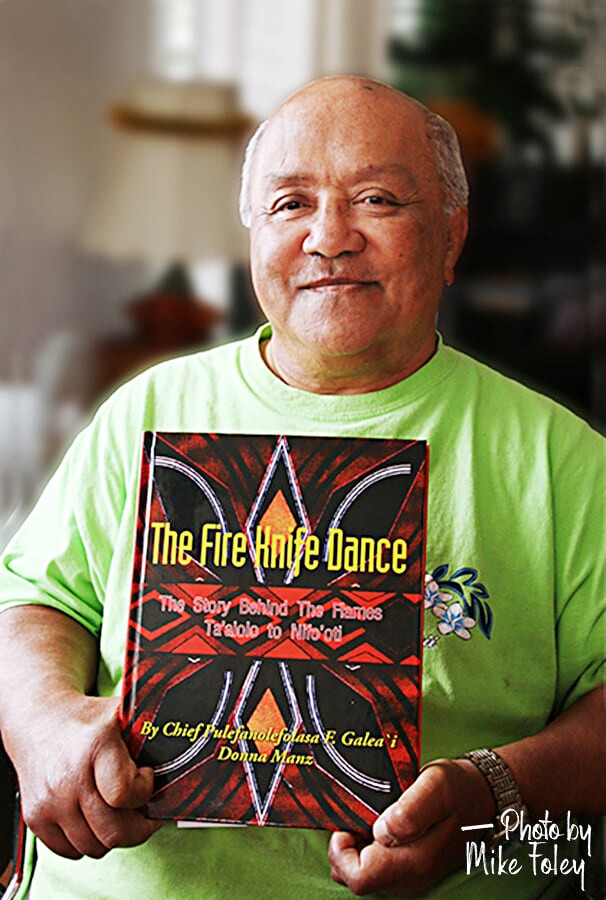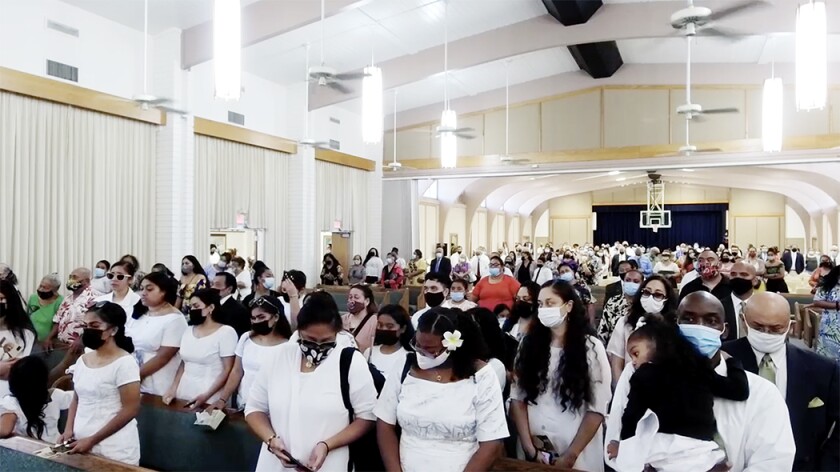
Family, friends, colleagues, fellow entertainers, other Samoan cultural experts, fire knife dancers and many others bid a “fond farewell” to Pulefanolefolasa Feagaimaali’i Galea’i during three recent events spread over three days. It was an unprecedented tribute by professional fire knife performers in front of his long-time home on Kulanui Street in Laie followed
by two separate funeral services.
Surrounded by blazing torches, the fire knife dancers, students – many of them relatives, and friends – marched along Kulanui St. to the Galea’i home on the evening of June 21, 2021, to the cadence of familiar drumming and performed on a scale even people in Laie have rarely seen.

Pule, or Pulefano as almost everybody called him, would have definitely approved, though typically, he might also have made suggestions on how the presentation could have been enhanced. That’s what he had done for many years at the Polynesian Cultural Center, as well as his own groups and numerous other events and competitions he helped stage in Honolulu, American Samoa and the U.S. mainland.
The next evening, June 22, some of the same people congregated in the Honolulu Tabernacle of The Church of Jesus Christ of Latter-day Saints for Pulefano’s first funeral. Hauula 5th Ward Bishop So’o Tufaga — a former Polynesian Cultural Center and professional fire knife dancer, and one of the many Galea’i cousins — requested and received special permission to hold the funeral there so Pule’s working acquaintances on that side of the island of Oahu could attend (while others watched it in a virtual broadcast).
Bishop Tufaga also conducted Pule’s final funeral in the Laie Hawaii Stake Center on June 23, which was followed by an unforgettable march to Laie Cemetery. Young men lined the streets with flaming torches. More than a dozen fire knife dancers performed in the traffic circle closest to the cemetery as the procession passed. Hundreds of people stood in honor of
one of Laie’s greatest Samoan cultural experts.
Even as a young teenager, Pulefano had begun to show his potential. He was was born in Mapusaga, American Samoa, in 1945; and like quite a few American Samoans, the U.S. Navy gave his father, Tuia Feagaimaali’i Galea’i — who was already recognized as a Samoan cultural expert, and several of the older boys in the family, the opportunity to migrate to Laie in 1952. Like many before and since, they came seeking a better education and to receive the blessings of the Laie Hawaii Temple — the only one in entire Pacific basin at that time.

His mother, Mealii Evelina Sitai and more children came next, finally followed by Pule and two other siblings. With the family together again in Laie, Tuia began teaching Pule the siva ‘ailao, or Samoan knife dance, and involving the children in the Latter-day Saint Hukilau program — a very popular visitor event that used to be held at what is now called Hukilau Beach.
When Church College of Hawaii organized its growing number of South Pacific students into a Polynesian performing group in the late 1950s, Tuia and Meali’i Galea’i helped train them in the Samoan portion of their program.
Smaller groups of them did gigs in Waikiki, and by the early 1960s the “Polynesian Panorama” group was appearing before sold-out crowds in Waikiki.
Meanwhile, at about age 14, Pulefano had already become the youngest professional fire knife dancer who was appearing regularly in Waikiki. At one point, he and his older brother, Tafili, were juggling fire knife dance shows at a half-dozen different venues; and of course, when the Church started up the PCC in October 1963, Pulefano and other members of his family were also involved there.
His older sister, Vatau, for example, acted as the chief’s taupou (or princess) for various cultural events and soon became the leader of the Samoan night show group. His younger sister, the late Vai Fa’amaligi, succeeded Vatau (who returned to American Samoa, and is now a retired educator). Today, Pulefano’s daughter, Maliana Ava, leads the Samoan night show group, and quite a few of his family members have lighted up the PCC stages with their outstanding fire knife dancing.
As Pulefano’s fame grew throughout Waikiki, he got drafted to travel and perform internationally and on the mainland. He also put together his own family-based group that performed for years in the Eastern U.S. and Canada; but when his mother’s health started declining in the early 1980s, he decided it was time to come home. He became a fulltime manager at the PCC and made many cultural contributions until he retired.
For example, in the early 1990s, when the U.S. economy tanked Hawaii’s tourism industry, the PCC management team decided to pursue a “special events” strategy to help –and Pulefano championed the idea to hold the first annual World Fireknife Championship in 1993, which continues to this day and in normal years is usually the Center’s biggest special event, attracting
thousands.
Typically, Pulefano appealed to knife dancers everywhere to join the competition, and he would even help train those who might benefit from his personal expertise. After the first one, he proposed adding the “We Are Samoa” high school cultural arts festival to the championship, and again, he would often travel around to the various Samoan high school clubs to help them prepare for the event.
He was the emcee for some of the programs, or else he could often be found in the Samoan Village talking to the competitors, giving them advice and encouragement. For some of the earlier years, he even personally made the unique over-sized wooden Samoan dancing knife trophies passed out to the winners; and even after he retired and had to get around in a mobility scooter, he attended all the events as both a fan and advisor.
In short, Pule was a Samoan cultural expert whose knowledge has been freely passed along to his children, other relatives, knife dancers, and many friends and colleagues. But remember, he also acted in several movie and TV shows, an extraordinary emcee, musician, singer, composer, lyricist, author (of several books), entertainer, and more.

But in his later years, he also focused a lot of that energy on his membership in the Church, and filled many voluntary callings..
As some of those who spoke during his two funeral services said, he often shared all of knowledge and expertise with others, helping them and treating many of them like his own family members.
For example, Tui Pule, a Samoan cultural advisor in Wai’anae, said during the funeral in Honolulu that Pulefano “took the time to nurture me…and he encouraged us. I’m proud to be a product of Pulefano.”
PCC emcee Sia Tonga described how Pulefano had given her daughters singing group, the Tonga Sisters, a lot of feedback as they’ve developed.
“The world says the only thing that connects us is blood, but I know what makes him my ‘uncle’ is love. We shared in common his love for culture.”
“The culture of Samoa [might be] reduced to three things: fa’aaloalo — respect, tautua — which can be described as service, and alofa, which is love. And the greatest of all these is love.”
Comparing him to the Savior’s parable of the talents, Tonga also said, “I see Uncle Pule as someone who not only multiplied his talents, but also he was the kind of person who would take your talents and shine them… and help you multiply your talents. That’s what the World Fireknife Championships and We Are Samoa Festival are to me.”
Hauula 5th Ward Bishop So’o Tufaga also pointed out that Pulefano had been faithful and diligent in sharing his time and talents most recently as a teacher in the missionary and temple preparation classes, and ward choir conductor. “He said, ‘Don’t just hear about the Plan of Salvation, understand it and live it.’”

His sister, Vatau, speaking in the Laie Stake Center funeral, said Pulefano — who served for quite a few years in bishoprics and as a stake high councilor — routinely demonstrated that the “whole purpose of our culture was to serve one another,” and “he put the Lord first, then the culture.”
Alex Galea’i, Pulefano’s son, said, “At the end of his life, Dad was all about missionary work... For him, it was [to] involve ourselves, and put into action what we know to be true.”
Truly, Pulefano left a legacy not only of Samoan culture for his own ‘āiga and many others, but also one of faith and devotion.
— Story by Mike “Mikaele” Foley, who knew and worked with Pulefano (and other of his family members) for a little over 50 years. As a young missionary in Samoa in the mid-1960s, he also served in Pulefano’s father’s ancestral village of Fitiuta, Manu’a, and his mother’s ancestral village, Āua, Tutuila, American Samoa.
Click here to watch a recent interview with Pulefano Galea'i and the BYUH Ho'okele Department.
